Integrated Photodetectors Based on Group IV and Colloidal Semiconductors: Current State of Affairs
Abstract
1. Introduction
- Single light sensors: A single sensor is used to detect overall light levels, it is useful to quantify the total optical power or light intensity;
- 1-D array light sensor: A line of PD is used to quantify the distribution of optical power or light intensity along a line. Combined with a wavelength splitter it can be used in a spectrophotometer; and
- 2-D array light sensor: A NxM matrix of photodetectors can be used to form images with NxM resolution.
2. Figure of Merits for Characterizing Photodetectors
- Quantum efficiency (QE): is the number of carriers (electrons or holes) generated per photon of a given energy. There are two types of QE: Internal quantum efficiency (IQE) that represents the number of charge carriers collected by the PD to the number of absorbed photons of a given energy, and external quantum efficiency (EQE) that is the number of charge carriers collected by the PD to the number of incident photons of a given energy.
- Responsivity (R): The ratio of photogenerated current Iph to input light power Pin, indicating the electrical response of an optical signal in units of A W−1,
- Spectral response: Describes the responsivity of a PD as a function of photon frequency.
- Specific detectivity (D*): Represents the ability to detect weak optical signals. D* depends on the specific measurement conditions comprising the bias voltage, operating temperature, wavelength and modulation frequency. It is expressed in units of cm Hz1/2 W−1 (Jones),where A is the effective area of the device, Δf is the electrical bandwidth and in is the noise current that includes the shot noise from the dark current, Johnson noise and flicker noise. However, D* is generally considered in the shot noise limit, thus the Johnson noise and flicker noise can be neglected. Thus, Equation (2) can be simplified as , where e is the electron charge, and Idark is the dark current.
- Response time: The time needed for a PD to rise or fall (τr/τf) from 10% to 90% or 90% to 10% of the final output.
- Noise-equivalent power (NEP): Indicates the lowest amount of light power needed to generate a signal comparable to the noise of the device (i.e., a signal-to-noise ratio of ≈1) when the electrical bandwidth of the noise measurement is equal to 1 Hz. The NEP (W Hz−1/2) is proportional to the reciprocal of D*,
- −3 dB bandwidth (f-3dB): Defined by the incident light modulation frequency at which the output signal is half-attenuated respect to its value under continuous wave illumination.
- Linear dynamic range (LDR): The range of incident light for which the detector responds linearly.
- Fill factor: The ratio of a light sensitive area of a pixel to its total area, typically it characterizes an image sensor array. The effective fill factor can be increased, often to nearly 100%, by using microlenses.
- Photoemission or photoelectric effect: Energy of photons supplies exactly the energy gap from the conduction band to free electrons, increasing the mobility of electrons.
- Thermal effect: Energy of photons supplies to mid-gap transition states then an electron decay back to lower bands, generating phonon and thus heat.
- Photochemical effect: In some materials, photons can induce a chemical change as crosslinking or the destruction of a chemical bond.
- Polarization effect: In some materials, photons can cause changes in polarization states, which can change the refractive index or induces birefringence effects.
3. Group IV Semiconductors
3.1. Si
3.2. Ge
3.3. Carbon
3.3.1. Carbon Nanotube
3.3.2. Graphene
4. Colloidal Semiconductor
4.1. Metal Oxide
4.2. HgTe and HgSe Nanocristals
5. Conclusions and Outlook
Author Contributions
Funding
Conflicts of Interest
References
- Jamroz, W.; Kruzelecky, R.; Haddad, E. Applied Microphotonics; CRC Press: Boca Raton, FL, USA, 2006; p. 1. ISBN 9780849340260. [Google Scholar]
- Soref, R.A. Microphotonics in-and-on silicon (state of the art and perspectives). In Silicon-Based Microphotonics: From Basics to Applications; Bisi, O., Campisano, L., Pavesi, L., Priolo, F., Eds.; IOS Press: Amsterdam, The Netherlands, 1999; pp. 1–20. [Google Scholar]
- Dardano, P.; Moretti, L.; Mocella, V.; Sirleto, L.; Rendina, I. Investigation of a tunable T-shaped waveguide based on a silicon 2D photonic crystal. J. Opt. A Pure Appl. Opt. 2006, 8, S554. [Google Scholar] [CrossRef]
- Mocella, V.; Cabrini, S.; Chang, A.S.P.; Dardano, P.; Moretti, L.; Rendina, I.; Olynick, D.; Harteneck, B.; Dhuey, S. Self-collimation of light over millimeter-scale distance in a quasi-zero-average-index metamaterial. Phys. Rev. Lett. 2009, 102, 133902. [Google Scholar] [CrossRef] [PubMed]
- Dardano, P.; Gagliardi, M.; Rendina, I.; Cabrini, S.; Mocella, V. Ellipsometric determination of permittivity in a negative index photonic crystal metamaterial. Light Sci. Appl. 2012, 1, e42. [Google Scholar] [CrossRef]
- Dardano, P.; Borrelli, M.; Musto, M.; Rotondo, G.; Iodice, M. Computational analysis of cooling dynamics in photonic-crystal-based thermal switches. J. Eur. Opt. Soc.-Rapid Publ. 2016, 12, 1–7. [Google Scholar] [CrossRef][Green Version]
- Dardano, P.; Caliò, A.; Politi, J.; Rea, I.; Rendina, I.; De Stefano, L. Optically monitored drug delivery patch based on porous silicon and polymer microneedles. Biomed. Opt. Express 2016, 7, 1645–1655. [Google Scholar] [CrossRef]
- Dardano, P.; Caliò, A.; Di Palma, V.; Bevilacqua, M.F.; Di Matteo, A.; De Stefano, L. A photolithographic approach to polymeric microneedles array fabrication. Materials 2015, 8, 8661–8673. [Google Scholar] [CrossRef]
- Politi, J.; Dardano, P.; Caliò, A.; Iodice, M.; Rea, I.; De Stefano, L. Reversible sensing of heavy metal ions using lysine modified oligopeptides on porous silicon and gold. Sens. Actuators B Chem. 2017, 244, 142–150. [Google Scholar] [CrossRef]
- Sirleto, L.; Ferrara, M.A.; Nikitin, T.; Novikov, S.; Khriachtchev, L. Giant Raman gain in silicon nanocrystals. Nat. Commun. 2012, 3, 1220. [Google Scholar] [CrossRef]
- Ferrara, M.A.; Rendina, I.; Basu, S.N.; Dal Negro, L.; Sirleto, L. Raman amplifier based on amorphous silicon nanoparticles. Int. J. Photoenergy 2012, 2012, 254946. [Google Scholar] [CrossRef]
- Ferrara, M.A.; Sirleto, L. Integrated Raman laser: A review of the last two decades. Micromachines 2020, 11, 330. [Google Scholar] [CrossRef]
- Hui, R. Photodetectors. In Introduction to Fiber-Optic Communications; Academic Press: Cambridge, MA, USA, 2020; pp. 125–154. [Google Scholar] [CrossRef]
- Xing, G.; Mathews, N.; Sun, S.; Lim, S.S.; Lam, Y.M.; Grätzel, M.; Mhaisalkar, S.; Sum, T.C. Long-Range Balanced Electron- and Hole-Transport Lengths in Organic-Inorganic CH3NH3PbI3. Science 2013, 342, 344–347. [Google Scholar] [CrossRef] [PubMed]
- Rogalski, A.; Antoszewski, J.; Faraone, L. Third-generation infrared photodetector arrays. J. Appl. Phys. 2009, 105, 091101. [Google Scholar] [CrossRef]
- Schneider, H.; Liu, H.C. Quantum Well Infrared Photodetectors, Physics and Applications; Springer: Heidelberg, Germany, 2006. [Google Scholar]
- Berryman, K.W.; Lyon, S.A.; Segev, M. Mid-infrared photoconductivity in InAs quantum dots. Appl. Phys. Lett. 1997, 70, 1861–1863. [Google Scholar] [CrossRef]
- Pan, D.; Towe, E.; Kennerly, S. Normal-incidence intersubband (In, Ga)As/GaAs quantum dot infrared photodetectors. Appl. Phys. Lett. 1998, 73, 1937–1939. [Google Scholar] [CrossRef]
- Sauvage, S.; Boucaud, P.; Brunhes, T. Midinfrared absorption and photocurrent spectroscopy of InAs/GaAs self-assembled quantum dots. Appl. Phys. Lett. 2001, 78, 2327–2329. [Google Scholar] [CrossRef][Green Version]
- Chakrabarti, S.; Stiff-Roberts, A.D.; Su, X.H.; Bhattacharya, P.; Ariyawansa, G.; Perera, A.G.U. High-performance mid-infrared quantum dot infrared photodetectors. J. Phys. D Appl. Phys. 2005, 38, 2135–2141. [Google Scholar] [CrossRef]
- Lim, H.; Tsao, S.; Zhang, W.; Razeghi, M. High-performance quantumdot infrared photodetectors grown on InP substrate operating at room temperature. Appl. Phys. Lett. 2007, 90, 131112. [Google Scholar] [CrossRef]
- Martyniuk, P.; Rogalski, A. Quantum-dot infrared photodetectors: Status and outlook. Prog. Quantum Electron. 2008, 32, 89–120. [Google Scholar] [CrossRef]
- Livache, C.; Martinez, B.; Goubet, N.; Ramade, J.; Lhuillier, E. Road Map for Nanocrystal Based Infrared Photodetectors. Front. Chem. 2018, 6, 575. [Google Scholar] [CrossRef]
- Song, J. Colloidal metal oxides in electronics and optoelectronics. In Colloidal Metal Oxide Nanoparticles; Sabu, T., Anu, T.S., Prajitha, V., Eds.; Elsevier: Amsterdam, The Netherlands, 2020; pp. 203–246. [Google Scholar]
- Yotter, R.A.; Wilson, D.M. A review of photodetectors for sensing light-emitting reporters in biological systems. IEEE Sens. J. 2003, 3, 288–303. [Google Scholar] [CrossRef]
- Ren, A.; Yuan, L.; Xu, H.; Wu, J.; Wang, Z. Recent progress of III–V quantum dot infrared photodetectors on silicon. J. Mater. Chem. C 2019, 7, 14441–14453. [Google Scholar] [CrossRef]
- Stöckmann, F. Photodetectors, their performance and their limitations. Appl. Phys. 1975, 7, 1–5. [Google Scholar] [CrossRef]
- Grinberg, A.A.; Luryi, S. Theory of the photon-drag effect in a two-dimensional electron gas. Phys. Rev. B 1988, 38, 87–96. [Google Scholar] [CrossRef] [PubMed]
- Bishop, P.; Gibson, A.; Kimmitt, M. The performance of photon-drag detectors at high laser intensities. IEEE J. Quantum Electron. 1973, 9, 1007–1011. [Google Scholar] [CrossRef]
- Herrscher, M.; Grundmann, M.; Dröge, E.; Bottcher, E.H.; Bimberg, D. Epitaxial liftoff InGaAs/InP MSM photodetectors on Si. Electron. Lett. 1995, 31, 1383–1384. [Google Scholar] [CrossRef]
- Walden, R.H. A review of recent progress in InP-based optoelectronic integrated circuit receiver front-ends. Int. J. High Speed Electron. Syst. 1998, 9, 631–642. [Google Scholar] [CrossRef]
- Masini, G.; Cencelli, V.; Colace, L.; De Notaristefani, F.; Assanto, G. Monolithic integration of near-infrared Ge photodetectors with Si complementary metal-oxide-semiconductor readout electronics. Appl. Phys. Lett. 2002, 80, 3268–3270. [Google Scholar] [CrossRef]
- Chui, C.O.; Okyay, A.K.; Saraswat, K.C. Effective dark current suppression with asymmetric MSM photodetectors in Group IV semiconductors. IEEE Photonics Technol. Lett. 2003, 15, 1585–1587. [Google Scholar] [CrossRef]
- Wohlmuth, W.A.; Arafa, M.; Mahajan, A.; Fay, P.; Adesida, I. InGaAs metal-semiconductor-metal photodetectors with engineered Schottky barrier heights. Appl. Phys. Lett. 1996, 69, 3578–3580. [Google Scholar] [CrossRef]
- Soole, J.B.D.; Schumacher, H. InGaAs metal-semiconductor-metal photodetectors for long wavelength optical communications. IEEE J. Quantum Electron. 1991, 27, 737–752. [Google Scholar] [CrossRef]
- Koester, S.J.; Schaub, J.D.; Dehlinger, G.; Chu, J.O. Germanium-on-SOI infrared detectors for integrated photonic applications. IEEE J. Sel. Top. Quantum Electron. 2006, 12, 1489–1502. [Google Scholar] [CrossRef]
- Harame, D.L.; Koester, S.J.; Freeman, G.; Cottrel, P.; Rim, K.; Dehlinger, G.; Ahlgren, D.; Dunn, J.S.; Greenberg, D.; Joseph, A.; et al. The revolution in SiGe: Impact on device electronics. Appl. Surf. Sci. 2004, 224, 9–17. [Google Scholar] [CrossRef]
- Wang, J.; Lee, S. Ge-Photodetectors for Si-Based Optoelectronic Integration. Sensors 2011, 11, 696–718. [Google Scholar] [CrossRef] [PubMed]
- Zhu, S.; Chu, H.S.; Lo, G.Q.; Bai, P.; Kwong, D.L. Waveguide-integrated near-infrared detector with self-assembled metal silicide nanoparticles embedded in a silicon p-n junction. Appl. Phys. Lett. 2012, 100, 061109. [Google Scholar] [CrossRef]
- Berini, P.; Olivieri, S.; Chen, C. Thin Au surface plasmon waveguide Schottky detectors on p-Si. Nanotechnology 2012, 23, 444011. [Google Scholar] [CrossRef]
- Akbari, A.; Tait, R.N.; Berini, P. Surface plasmon waveguide Schottky detector. Opt. Express 2010, 18, 8505–8514. [Google Scholar] [CrossRef]
- Sobhani, A.; Knight, M.W.; Wang, Y.; Zheng, B.; King, N.S.; Brown, L.V.; Fang, Z.; Nordlander, P.; Halas, N.J. Narrowband photodetection in the near-infrared with a plasmon-induced hot electron device. Nat. Commun. 2013, 4, 1643. [Google Scholar] [CrossRef]
- Amirmazlaghani, M.; Raissi, F.; Habibpour, O.; Vukusic, J.; Stake, J. Graphene-Si Schottky IR detector. IEEE J. Quant. Electron. 2013, 49, 589–594. [Google Scholar] [CrossRef]
- Casalino, M.; Sirleto, L.; Iodice, M.; Coppola, G. Silicon photodetectors: The challenge of detecting near-infrared light. In Photodetectors; Gateva, S., Ed.; InTech: London, UK, 2012; pp. 51–76. [Google Scholar] [CrossRef]
- Casalino, M. Recent Advances in Silicon Photodetectors Based on the Internal Photoemission Effect. In New Research on Silicon-Structure, Properties, Technology; Talanin, V.I., Ed.; InTech: London, UK, 2017; pp. 245–266. [Google Scholar] [CrossRef]
- Kimata, M.; Ueno, M.; Yagi, H.; Shiraishi, T.; Kawai, M.; Endo, K.; Kosasayama, Y.; Sone, T.; Ozeki, T.; Tsubouchi, N. PtSi Schottky-barrier infrared focal plane arrays. Opto-Electron. Rev. 1998, 6, 1–10. [Google Scholar]
- Sakib, M.; Sun, J.; Kumar, R.; Driscoll, J.; Yeung, K.; Rong, H. Demonstration of a 50 Gb/s all-silicon waveguide photodetector for photonic integration. In Proceedings of the Conference on Lasers and Electro-Optics, OSA Technical Digest (online) 2018, San Jose, CA, USA, 13–18 May 2018; p. JTh5A.7. [Google Scholar] [CrossRef]
- Fang, X.S.; Bando, Y.; Liao, M.Y.; Gautam, U.K.; Zhi, C.Y.; Dierre, B.; Liu, B.D.; Zhai, T.Y.; Sekiguchi, T.; Koide, Y.; et al. Single-Crystalline ZnS Nanobelts as Ultraviolet-Light Sensors. Adv. Mater. 2009, 21, 2034–2039. [Google Scholar] [CrossRef]
- Huang, X.; Wang, M.; Willinger, M.G.; Shao, L.D.; Su, D.S.; Meng, X.M. Assembly of three-dimensional hetero-epitaxial ZnO/ZnS core/shell nanorod and single crystalline hollow ZnS nanotube arrays. ACS Nano 2012, 6, 7333–7339. [Google Scholar] [CrossRef] [PubMed]
- Tian, W.; Liu, D.; Cao, F.; Li, L. Hybrid Nanostructures for Photodetectors. Adv. Opt. Mater. 2017, 5, 1600468. [Google Scholar] [CrossRef]
- Sun, J.; Han, M.; Gu, Y.; Yang, Z.-X.; Zeng, H. Recent Advances in Group III–V Nanowire Infrared Detectors. Adv. Opt. Mater. 2018, 6, 1800256. [Google Scholar] [CrossRef]
- Yang, C.; Barrelet, C.J.; Capasso, F.; Lieber, C.M. Hybrid Single-Nanowire Photonic Crystal and Microresonator Structures. Nano Lett. 2006, 6, 2929. [Google Scholar] [CrossRef] [PubMed]
- Liang, F.-X.; Wang, J.-Z.; Li, Z.-P.; Luo, L.-B. Near-Infrared-Light Photodetectors Based on One-Dimensional Inorganic Semiconductor Nanostructures. Adv. Optical Mater. 2017, 5, 1700081. [Google Scholar] [CrossRef]
- Wu, C.Y.; Pan, Z.Q.; Wang, Y.Y.; Ge, C.W.; Yu, Y.Q.; Xu, J.Y.; Wang, L.; Luo, L.B. Core–shell silicon nanowire array–Cu nanofilm Schottky junction for a sensitive self-powered near-infrared photodetector. J. Mater. Chem. C 2016, 4, 10804–10811. [Google Scholar] [CrossRef]
- Mulazimoglu, E.; Coskun, S.; Gunoven, M.; Butun, B.; Ozbay, E.; Turan, R.; Unalan, H.E. Silicon nanowire network metal-semiconductor-metal photodetectors. Appl. Phys. Lett. 2013, 103, 083114. [Google Scholar] [CrossRef]
- Das, K.; Mukherjee, S.; Manna, S.; Raychaudhuri, A.K. Single Si nanowire (diameter ≤ 100 nm) based polarization sensitive near-infrared photodetector with ultra-high responsivity. Nanoscale 2014, 6, 11232–11239. [Google Scholar] [CrossRef]
- Cao, Y.; Zhu, J.; Xu, J.; He, J.; Sun, J.L.; Wang, Y.; Zhao, Z. Ultra-Broadband Photodetector for the Visible to Terahertz Range by Self-Assembling Reduced Graphene Oxide-Silicon Nanowire Array Heterojunctions. Small 2014, 10, 2345–2351. [Google Scholar] [CrossRef]
- Xie, C.; Nie, B.; Zeng, L.H.; Liang, F.X.; Wang, M.Z.; Luo, L.B.; Feng, M.; Yu, Y.Q.; Wu, C.Y.; Wu, Y.C.; et al. Core-shell heterojunction of silicon nanowire arrays and carbon quantum dots for photovoltaic devices and self-driven photodetectors. ACS Nano 2014, 8, 4015–4022. [Google Scholar] [CrossRef]
- Yatsui, T.; Okada, S.; Takemori, T.; Sato, T.; Saichi, K.; Ogamoto, T.; Chiashi, S.; Maruyama, S.; Noda, M.; Yabana, K.; et al. Enhanced photo-sensitivity in a Si photodetector using a near-field assisted excitation. Commun. Phys. 2019, 2, 62. [Google Scholar] [CrossRef]
- Huang, S.; Wu, Q.; Jia, Z.; Jin, X.; Fu, X.; Huang, H.; Zhang, X.; Yao, J.; Xu, J. Black Silicon Photodetector with Excellent Comprehensive Properties by Rapid Thermal Annealing and Hydrogenated Surface Passivation. Adv. Opt. Mater. 2020, 8, 1901808. [Google Scholar] [CrossRef]
- Benedikovic, D.; Virot, L.; Aubin, G.; Hartmann, J.-M.; Amar, F.; Szelag, B.; Le Roux, X.; Alonso-Ramos, C.; Crozat, P.; Cassan, É.; et al. Comprehensive Study on Chip-Integrated Germanium Pin Photodetectors for Energy-Efficient Silicon Interconnects. IEEE J. Quantum Electron. 2020, 56, 8400409. [Google Scholar] [CrossRef]
- Samavedam, S.B.; Currie, M.T.; Langdo, T.A.; Fitzgerald, E.A. High-quality germanium photodiodes integrated on silicon substrates using optimized relaxed graded buffers. Appl. Phys. Lett. 1998, 73, 2125–2127. [Google Scholar] [CrossRef]
- Zhang, Y.; Yang, S.; Yang, Y.; Gould, M.; Ophir, N.; Eu-Jin Lim, A.; Lo, G.-Q.; Magill, P.; Bergman, K.; Baehr-Jones, T.; et al. A high-responsivity photodetector absent metalgermanium direct contact. Opt. Exp. 2014, 22, 11367–11375. [Google Scholar] [CrossRef]
- Lischke, S.; Knoll, D.; Mai, C.; Zimmermann, L.; Peczek, A.; Kroh, M.; Trusch, A.; Krune, E.; Voigt, K.; Mai, A. High bandwidth, high responsivity waveguidecoupled germanium p-i-n photodiode. Opt. Exp. 2015, 23, 27213–27220. [Google Scholar] [CrossRef]
- Virot, L.; Benedikovic, D.; Szelag, B.; Alonso-Ramos, C.; Karakus, B.; Hartmann, J.-M.; Le Roux, X.; Crozat, P.; Cassan, E.; Marris-Morini, D.; et al. Integrated waveguide PIN photodiodes exploiting lateral Si/Ge/Si heterojunction. Opt. Exp. 2017, 25, 19487–19496. [Google Scholar] [CrossRef]
- Chen, H.; Verheyen, P.; De Heyn, P.; Lepage, G.; De Coster, J.; Balakrishnan, S.; Absil, P.; Yao, W.; Shen, L.; Roelkens, G.; et al. −1 V bias 67 GHz bandwidth Si-contacted germanium waveguide p-i-n photodetector for optical links at 56 Gbps and beyond. Opt. Exp. 2016, 24, 4622–4631. [Google Scholar] [CrossRef]
- Benedikovic, D.; Virot, L.; Aubin, G.; Amar, F.; Szelag, B.; Karakus, B.; Hartmann, J.-M.; Alonso-Ramos, C.; Le Roux, X.; Crozat, P.; et al. 25 Gbps low-voltage hetero-structured silicongermanium waveguide pin photodetectors for monolithic on-chip nanophotonic architectures. Photon. Res. 2019, 7, 437–444. [Google Scholar] [CrossRef]
- Tzu, T.; Sun, K.; Costanzo, R.; Ayoub, D.; Bowers, S.M.; Beling, A. Foundry-Enabled High-Power Photodetectors for Microwave Photonics. IEEE J. Sel. Top. Quantum Electron. 2019, 25, 3800111. [Google Scholar] [CrossRef]
- Hu, W.; Cong, H.; Huang, W.; Huang, Y.; Chen, L.; Pan, A.; Xue, C. Germanium/perovskite heterostructure for high-performance and broadband photodetector from visible to infrared telecommunication band. Light Sci. Appl. 2019, 8, 106. [Google Scholar] [CrossRef]
- Siontas, S.; Wang, H.; Li, D.; Zaslavsky, A.; Pacifici, D. Broadband visible-to-telecom wavelength germanium quantum dot photodetectors. Appl. Phis. Lett. 2018, 113, 181101. [Google Scholar] [CrossRef]
- Kumar, S.; Chatterjee, A.; Selvaraja, S.K.; Avasthi, S. Two-Step Liquid Phase Crystallized Germanium-Based Photodetector for Near-Infrared Applications. IEEE Sens. J. 2020, 20, 4660–4666. [Google Scholar] [CrossRef]
- Wang, Y. Photoconductivity of fullerene-doped polymers. Nature 1992, 356, 585–587. [Google Scholar] [CrossRef]
- Baker, S.N.; Baker, G.A. Luminescent Carbon Nanodots: Emergent Nanolights. Angew. Chem. Int. Ed. 2010, 49, 6726–6744. [Google Scholar] [CrossRef]
- Baughman, R.H.; Cui, C.; Zakhidov, A.A.; Iqbal, Z.; Barisci, J.N.; Spinks, G.M.; Wallace, G.G.; Mazzoldi, A.; De Rossi, D.; Rinzler, A.G.; et al. Carbon Nanotube Actuators. Science 1999, 284, 1340–1344. [Google Scholar] [CrossRef]
- Zhang, G.L.; Zhou, R.L.; Zeng, X.C. Carbon nanotube and boron nitride nanotube hosted C-60-V nanopeapods. J. Mater. Chem. C 2013, 1, 4518–4526. [Google Scholar] [CrossRef][Green Version]
- Nair, R.R.; Blake, P.; Grigorenko, A.N.; Novoselov, K.S.; Booth, T.J.; Stauber, T.; Peres, N.M.R.; Geim, A.K. Fine structure constant defines visual transparency of graphene. Science 2008, 320, 1308. [Google Scholar] [CrossRef]
- Ponomarenko, L.A.; Schedin, F.; Katsnelson, M.I.; Yang, R.; Hill, E.W.; Novoselov, K.S.; Geim, A.K. Chaotic Dirac billiard in graphene quantum dots. Science 2008, 320, 356–358. [Google Scholar] [CrossRef]
- Huynh, W.U.; Dittmer, J.J.; Alivisatos, A.P. Hybrid nanorod-polymer solar cells. Science 2002, 295, 2425–2427. [Google Scholar] [CrossRef]
- He, X.; Léonard, F.; Kono, J. Uncooled Carbon Nanotube Photodetectors. Adv. Opt. Mater. 2015, 3, 989–1011. [Google Scholar] [CrossRef]
- Zhang, T.-F.; Li, Z.-P.; Wang, J.-Z.; Kong, W.-Y.; Wu, G.-A.; Zheng, Y.-Z.; Zhao, Y.-W.; Yao, E.-X.; Zhuang, N.-X.; Luo, L.-B. Broadband photodetector based on carbon nanotube thin film/single layer graphene Schottky junction. Sci. Rep. 2016, 6, 38569. [Google Scholar] [CrossRef]
- Freitag, M.; Martin, Y.; Misewich, J.A.; Martel, R.; Avouris, P.H. Photoconductivity of single carbon nanotubes. Nano Lett. 2003, 3, 1067–1071. [Google Scholar] [CrossRef]
- Lu, R.T.; Shi, J.J.; Baca, F.J.; Wu, J.Z. High performance multiwall carbon nanotube bolometers. J. Appl. Phys. 2010, 108, 084305. [Google Scholar] [CrossRef]
- Chen, H.Z.; Xi, N.; Song, B.; Chen, L.; Zhao, J.; Lai, K.W.C.; Yang, R. Infrared Camera Using a Single Nano-Photodetector. IEEE Sens. J. 2013, 13, 949–958. [Google Scholar] [CrossRef]
- Balasubramanian, K.; Burghard, M.; Kern, K.; Scolari, M.; Mews, A. Photocurrent Imaging of Charge Transport Barriers in Carbon Nanotube Devices. Nano Lett. 2005, 5, 507–510. [Google Scholar] [CrossRef]
- Lee, J.U. Photovoltaic effect in ideal carbon nanotube diodes. Appl. Phys. Lett. 2005, 87, 073101. [Google Scholar] [CrossRef]
- Avouris, P.; Freitag, M.; Perebeinos, V. Carbon-nanotube photonics and optoelectronics. Nat. Photonics 2008, 2, 341–350. [Google Scholar] [CrossRef]
- Yang, L.; Wang, S.; Zeng, Q.; Zhang, Z.; Peng, L.M. Carbon nanotube photoelectronic and photovoltaic devices and their applications in infrared detection. Small 2013, 9, 1225–1236. [Google Scholar] [CrossRef]
- Xie, Y.; Gong, M.; Shastry, T.A.; Lohrman, J.; Hersam, M.C.; Ren, S. Broad-Spectral-Response Nanocarbon Bulk-Heterojunction Excitonic Photodetectors. Adv. Mater. 2013, 25, 3433–3437. [Google Scholar] [CrossRef]
- Bindl, D.J.; Wu, M.-Y.; Prehn, F.C.; Arnold, M.S. Efficiently Harvesting Excitons From Electronic Type-Controlled Semiconducting Carbon Nanotube Films. Nano Lett. 2011, 11, 455–460. [Google Scholar] [CrossRef] [PubMed]
- Liang, L.; Ma, Z.; Wu, G.; Wei, N.; Huang, L.; Huang, H.; Liu, H.; Wang, S.; Peng, L.-M. Microcavity-Integrated Carbon Nanotube Photodetectors. ACS Nano 2016, 10, 6963–6971. [Google Scholar] [CrossRef] [PubMed]
- Cheng, S.H.; Weng, T.-M.; Lu, M.-L.; Tan, W.-C.; Chen, J.-Y.; Chena, Y.-F. All carbon-based photodetectors: An eminent integration of graphite quantum dots and two dimensional grapheme. Sci. Rep. 2013, 3, 454. [Google Scholar] [CrossRef] [PubMed]
- Zhang, H.B.; Zhang, X.J.; Liu, C.; Lee, S.T.; Jie, J.S. High-Responsivity, High-Detectivity, Ultrafast Topological Insulator Bi2Se3/Silicon Heterostructure Broadband Photodetectors. ACS Nano 2016, 10, 5113–5122. [Google Scholar] [CrossRef]
- Salvato, M.; Scagliotti, M.; De Crescenzi, M.; Boscardin, M.; Attanasio, C.; Avallone, G.; Cirillo, C.; Prosposito, P.; De Matteins, F.; Messi, R.; et al. Time response in carbon nanotube/Si based photodetectors. Sens. Actuators A Phys. 2019, 292, 71–76. [Google Scholar] [CrossRef]
- Balandin, A.A.; Ghosh, S.; Bao, W.; Calizo, I.; Teweldebrhan, D.; Miao, F.; Lau, C.N. Superior Thermal Conductivity of Single-Layer Graphene. Nano Lett. 2008, 8, 902–907. [Google Scholar] [CrossRef]
- Koppens, F.H.L.; Mueller, T.; Ferrari, A.C.; Vitiello, M.S.; Polini, M. Photodetectors based on graphene, other two-dimensional materials and hybrid systems. Nat. Nanotech. 2014, 9, 780–793. [Google Scholar] [CrossRef]
- Guo, N.; Hu, W.; Jiang, T.; Gong, F.; Luo, W.; Qiu, W.; Wang, P.; Liu, L.; Wu, S.; Liao, L.; et al. High-Quality Infrared Imaging with Graphene Photodetectors at Room Temperature. Nanoscale 2016, 8, 16065–16072. [Google Scholar] [CrossRef]
- Xia, F.; Mueller, T.; Lin, Y.-M.; Valdes-Garcia, A.; Avouris, P. Ultrafast graphene photodetector. Nat. Nanotechnol. 2009, 4, 839–843. [Google Scholar] [CrossRef]
- Bao, W.; Jing, L.; Velasco, J., Jr.; Lee, Y.; Liu, G.; Tran, D.; Standley, B.; Aykol, M.; Cronin, S.B.; Smirnov, D.; et al. Stacking-dependent band gap and quantum transport in trilayer graphene. Nat. Phys. 2011, 7, 948–952. [Google Scholar] [CrossRef]
- Nie, B.; Hu, J.-G.; Luo, L.-B.; Xie, C.; Zeng, L.-H.; Lv, P.; Li, F.-Z.; Jie, J.-S.; Feng, M.; Wu, C.-Y.; et al. Monolayer Graphene Film on ZnO Nanorod Array for High-Performance Schottky Junction Ultraviolet Photodetectors. Small 2013, 9, 2872–2879. [Google Scholar] [CrossRef] [PubMed]
- Dang, V.Q.; Trung, T.Q.; Kim, D.-I.; Duy, L.T.; Hwang, B.-U.; Lee, D.-W.; Kim, B.-Y.; Toan, L.D.; Lee, N.-E. Ultrahigh Responsivity in Graphene–ZnO Nanorod Hybrid UV Photodetector. Small 2015, 11, 3054–3065. [Google Scholar] [CrossRef] [PubMed]
- Luo, L.B.; Zhang, S.H.; Lu, R.; Sun, W.; Fang, Q.L.; Wu, C.Y.; Hu, J.; Wang, L. P-type ZnTe:Ga nanowires: Controlled doping and optoelectronic device application. RSC Adv. 2015, 5, 13324–13330. [Google Scholar] [CrossRef]
- Luo, L.B.; Zhang, S.-H.; Lu, R.; Sun, W.; Fang, Q.-L.; Wu, C.-Y.; Hua, J.-G.; Wang, L. Light trapping and surface plasmon enhanced high-performance NIR photodetector. Sci. Rep. 2014, 4, 3914. [Google Scholar] [CrossRef] [PubMed]
- Goykhman, I.; Sassi, U.; Desiatov, B.; Mazurski, N.; Milana, S.; de Fazio, D.; Eiden, A.; Khurgin, J.; Shappir, J.; Levy, U.; et al. On-Chip Integrated, Silicon–Graphene PlasmonicSchottky Photodetector with High Responsivity and Avalanche Photogain. Nano Lett. 2015, 16, 3005–3013. [Google Scholar] [CrossRef]
- Zeng, L.H.; Wang, M.-Z.; Hu, H.; Nie, B.; Yu, Y.-Q.; Wu, C.-Y.; Wang, L.; Hu, J.-G.; Xie, C.; Liang, F.-X.; et al. Monolayer graphene/germanium Schottky junction as high-performance self-driven infrared light photodetector. ACS Appl. Mater. Interfaces 2013, 5, 9362–9366. [Google Scholar] [CrossRef] [PubMed]
- Petronijevic, E.; Leahu, G.; Di Meo, V.; Crescitelli, A.; Dardano, P.; Coppola, G.; Esposito, E.; Rendina, I.; Miritello, M.; Grimaldi, M.G.; et al. Near-infrared modulation by means of GeTe/SOI-based metamaterial. Opt. Lett. 2019, 44.6, 1508–1511. [Google Scholar] [CrossRef]
- Kumar, A.; Kashild, R.; Ghosh, A.; Kumar, V.; Singh, R. Enhanced Thermionic Emission and Low 1/f Noise in Exfoliated Graphene/GaN Schottky Barrier Diode. ACS Appl. Mater. Interfaces 2016, 8, 8213–8223. [Google Scholar] [CrossRef]
- Miao, J.S.; Hu, W.; Guo, N.; Lu, Z.; Liu, X.; Liao, L.; Chen, P.; Jiang, T.; Wu, S.; Ho, J.C.; et al. High-Responsivity Graphene/InAs Nanowire Heterojunction Near-Infrared Photodetectors with Distinct Photocurrent On/Off Ratio. Small 2015, 11, 936–942. [Google Scholar] [CrossRef]
- Xu, J.; Liu, T.; Hu, H.; Zhai, Y.; Chen, K.; Chen, N.; Li, C.; Zhang, X. Design and optimization of tunneling photodetectors based on graphene/Al2O3/silicon heterostructures. Nanophotonics 2020, 20190499, 2192–8614. [Google Scholar] [CrossRef]
- Shin, D.H.; Choi, S.-H. Graphene-Based Semiconductor Heterostructures for Photodetectors. Micromachines 2018, 9, 350. [Google Scholar] [CrossRef] [PubMed]
- Casalino, M. Silicon Meets Graphene for a New Family of Near-Infrared Schottky Photodetectors. Appl. Sci. 2019, 9, 3677. [Google Scholar] [CrossRef]
- Periyanagounder, D.; Gnanasekar, P.; Varadhan, P.; He, J.-H.; Kulandaivel, J. High performance, self-powered photodetectors based on a graphene/silicon Schottky junction diode. J. Mater. Chem. C 2018, 6, 9545–9551. [Google Scholar] [CrossRef]
- Ma, P.; Salamin, Y.; Baeuerle, B.; Josten, A.; Heni, W.; Emboras, A.; Leuthold, J. Plasmonically Enhanced Graphene Photodetector Featuring 100 Gbit/s Data Reception, High Responsivity, and Compact Size. ACS Photonics 2019, 6, 154–161. [Google Scholar] [CrossRef]
- Keller, A.A.; Wang, H.; Zhou, D.; Lenihan, H.S.; Cherr, G.; Cardinale, B.J.; Miller, R.; Ji, Z. Stability and aggregation of metal oxide nanoparticles in natural aqueous matrices. Environ. Sci. Technol. 2010, 44, 1962–1967. [Google Scholar] [CrossRef] [PubMed]
- ELeite, R.; Maciel, A.P.; Weber, I.T.; Lisboa-Filho, P.N.; Longo, E.; Paiva-Santos, C.O.; Andrade, A.V.C.; Pakoscimas, C.A.; Maniette, Y.; Schreiner, H.W. Development of metal oxide nanoparticles with high stability against particle growth using a metastable solid solution. Adv. Mater. 2002, 14, 905–908. [Google Scholar]
- Buonsanti, R.; Llordes, A.; Aloni, S.; Helms, B.A.; Milliron, D.J. Tunable infrared absorption and visible transparency of colloidal aluminum-doped zinc oxide nanocrystals. Nano Lett. 2011, 11, 4706–4710. [Google Scholar] [CrossRef]
- Farvid, S.S.; Wang, T.; Radovanovic, P.V. Colloidal gallium indium oxide nanocrystals: A multifunctional light-emitting phosphor broadly tunable by alloy composition. J. Am. Chem. Soc. 2011, 133, 6711–6719. [Google Scholar] [CrossRef]
- De Trizio, L.; Buonsanti, R.; Schimpf, A.M.; Llordes, A.; Gamelin, D.R.; Simonutti, R.; Milliron, D.J. Nb-doped colloidal TiO2 nanocrystals with tunable infrared absorption. Chem. Mater. 2013, 25, 3383–3390. [Google Scholar] [CrossRef]
- Lee, S.; Jeong, Y.; Jeong, S.; Lee, J.; Jeon, M.; Moon, J. Solution-processed ZnO nanoparticle-based semiconductor oxide thin-film transistors. Superlattice. Microst. 2008, 44, 761–769. [Google Scholar] [CrossRef]
- Jun, J.H.; Seong, H.; Cho, K.; Moon, B.M.; Kim, S. Ultraviolet photodetectors based on ZnO nanoparticles. Ceram. Int. 2009, 35, 2797–2801. [Google Scholar] [CrossRef]
- Neshataeva, E.; Kummell, T.; Bacher, G.; Ebbers, A. All-inorganic light emitting device based on ZnO nanoparticles. Appl. Phys. Lett. 2009, 94, 091115. [Google Scholar] [CrossRef]
- Wang, M.Q.; Lian, Y.Q.; Wang, X.G. PPV/PVA/ZnO nanocomposite prepared by complex precursor method and its photovoltaic application. Curr. Appl. Phys. 2009, 9, 189–194. [Google Scholar] [CrossRef]
- Saidaminov, M.I.; Adinolfi, V.; Comin, R.; Abdelhady, A.L.; Peng, W.; Dursun, I.; Yuan, M.; Hoogland, S.; Sargent, E.H.; Bakr, O.M. Planar-integrated single-crystalline perovskite photodetectors. Nat. Commun. 2015, 6, 8724. [Google Scholar] [CrossRef]
- Fu, X.-W.; Liao, Z.-M.; Zhou, Y.-B.; Wu, H.C.; Bie, Y.Q.; Xu, J.; Yu, D.P. Graphene/ZnO nanowire/graphene vertical structure based fast-response ultraviolet photodetector. Appl. Phys. Lett. 2012, 100, 223114. [Google Scholar] [CrossRef]
- Lopez-Sanchez, O.; Lembke, D.; Kayci, M.; Radenovic, A.; Kis, A. Ultrasensitive photodetectors based on monolayer MoS2. Nat. Nanotechnol. 2013, 8, 497–501. [Google Scholar] [CrossRef]
- Dou, L.T.; Yang, Y.; You, J.B.; Hong, Z.; Chang, W.H.; Li, G.; Yang, Y. Solution-processed hybrid perovskite photodetectors with high detectivity. Nat. Commun. 2014, 5, 5404. [Google Scholar] [CrossRef]
- Han, Y.G.; Wu, G.; Wang, M.; Chen, H. High efficient UV-A photodetectors based on monodispersed ligand-capped TiO2 nanocrystals and polyfluorene hybrids. Polymer 2010, 51, 3736–3743. [Google Scholar] [CrossRef]
- Jin, Y.Z.; Wang, J.P.; Sun, B.Q.; Blakesley, J.C.; Greenham, N.C. Solution-processed ultraviolet photodetectors based on colloidal ZnO nanoparticles. Nano Lett. 2008, 8, 1649–1653. [Google Scholar] [CrossRef]
- Zhai, T.Y.; Fang, X.S.; Liao, M.Y.; Xu, X.; Zeng, H.; Yoshio, B.; Golberg, D. A comprehensive review of one-dimensional metal-oxide nanostructure photodetectors. Sensors 2009, 9, 6504–6529. [Google Scholar] [CrossRef]
- Sang, L.W.; Liao, M.Y.; Sumiya, M. A comprehensive review of semiconductor ultraviolet photodetectors: From thin film to one-dimensional nanostructures. Sensors 2013, 13, 10482–10518. [Google Scholar] [CrossRef]
- Hu, L.F.; Yan, J.; Liao, M.Y.; Wu, L.; Fang, X. Ultrahigh external quantum efficiency from thin SnO2 nanowire ultraviolet photodetectors. Small 2011, 7, 1012–1017. [Google Scholar] [CrossRef] [PubMed]
- Li, L.; Lee, P.S.; Yan, C.Y.; Zhai, T.; Fang, X.; Liao, M.; Koide, Y.; Bando, Y.; Golberg, D. Ultrahigh-performance solar-blind photodetectors based on individual single-crystalline In2Ge2O7 nanobelts. Adv. Mater. 2010, 22, 5145–5149. [Google Scholar] [CrossRef] [PubMed]
- Fang, X.S.; Hu, L.F.; Huo, K.F.; Gao, B.; Zhao, L.; Liao, M.; Chu, P.K.; Bando, Y.; Golberg, D. New ultraviolet photodetector based on individual Nb2O5 nanobelts. Adv. Funct. Mater. 2011, 21, 3907–3915. [Google Scholar] [CrossRef]
- Wang, J.X.; Yan, C.Y.; Kang, W.B.; Lee, P.S. High-efficiency transfer of percolating nanowire films for stretchable and transparent photodetectors. Nanoscale 2014, 6, 10734–10739. [Google Scholar] [CrossRef]
- Li, L.D.; Gu, L.L.; Lou, Z.; Shen, G. ZnO quantum dot decorated Zn2SnO4 nanowire heterojunction photodetectors with drastic performance enhancement and flexible ultraviolet image sensors. ACS Nano 2017, 11, 4067–4076. [Google Scholar] [CrossRef]
- Wu, L.; Wu, Y.S.; Pan, X.R.; Kong, F. Synthesis of ZnO nanorod and the annealing effect on its photoluminescence property. Opt. Mater. 2006, 28, 418–422. [Google Scholar] [CrossRef]
- Wu, Y.L.; Tok, A.I.Y.; Boey, F.Y.C.; Zeng, X.T.; Zhang, X.H. Surface modification of ZnO nanocrystals. Appl. Surf. Sci. 2007, 253, 5473–5479. [Google Scholar] [CrossRef]
- Qin, L.Q.; Shing, C.; Sawyer, S. Metal-semiconductor-metal ultraviolet photodetectors based on zinc-oxide colloidal nanoparticles. IEEE Electron Device Lett. 2011, 32, 51–53. [Google Scholar] [CrossRef]
- Khokhra, R.; Bharti, B.; Lee, H.-N.; Kumar, R. Visible and UV photo-detection in ZnO nanostructured thin films via simple tuning of solution method. Sci. Rep. 2017, 7, 15032. [Google Scholar] [CrossRef]
- Gogurla, N.; Sinha, A.K.; Santra, S.; Manna, S.; Ray, S.K. Multifunctional Au-ZnO plasmonic nanostructures for enhanced UV photodetector and room temperature NO sensing devices. Sci. Rep. 2014, 4, 6483. [Google Scholar] [CrossRef] [PubMed]
- Ismail, R.A.; Ali, A.K.; Hassoon, K.I. Preparation of a silicon heterojunction photodetector from colloidal indium oxide nanoparticles. Opt. Laser Technol. 2013, 51, 1–4. [Google Scholar] [CrossRef]
- Seong, H.; Cho, K.; Kim, S. Photocurrent characteristics of solutionprocessed HgTe nanoparticle thin films under the illumination of 1.3 μm wavelength light. Semicond. Sci. Technol. 2008, 23, 075011. [Google Scholar] [CrossRef]
- Jana, M.K.; Chithaiah, P.; Murali, B.; Krupanidhi, S.B.; Biswas, K.; Rao, C.N.R. Near infrared detectors based on HgSe and HgCdSe quantum dots generated at the liquid–liquid interface. J. Mater. Chem. C 2013, 1, 6184–6187. [Google Scholar] [CrossRef]
- Chen, M.; Yu, H.; Kershaw, S.V.; Xu, H.; Gupta, S.; Hetsch, F.; Rogach, A.L.; Zhao, N. Fast, air-stable infrared photodetectors based on spraydeposited aqueous HgTe quantum dots. Adv. Funct. Mater. 2014, 24, 53–59. [Google Scholar] [CrossRef]
- Im, S.H.; Kim, H.; Kim, S.W.; Kim, S.-W.; Il Seok, S. Efficient HgTe colloidal quantum dot-sensitized near-infrared photovoltaic cells. Nanoscale 2012, 4, 1581–1584. [Google Scholar] [CrossRef]
- Nam, M.; Kim, S.; Kim, S.; Jeong, S.; Kim, S.-W.; Lee, K. Near-infrared-sensitive bulk heterojunction solar cells using nanostructured hybrid composites of HgTe quantum dots and a low-band gap polymer. Sol. Energy Mater. Sol. Cells 2014, 126, 163–169. [Google Scholar] [CrossRef]
- Lhuillier, E.; Guyot-Sionnest, P. Recent progresses in mid infrared nanocrystal optoelectronics. IEEE J. Sel. Top. Quantum Electron. 2017, 23, 1–8. [Google Scholar] [CrossRef]
- Jia, B.W.; Tan, K.H.; Loke, W.K.; Wicaksono, S.; Lee, K.H.; Yoon, S.F. Monolithic integration of insb photodetector on silicon for mid-infrared silicon photonics. ACS Photonics 2018, 5, 1512–1520. [Google Scholar] [CrossRef]
- Iacovo, A.D.; Venettacci, C.; Colace, L.; Scopa, L.; Foglia, S. PbS colloidal quantum dot visible-blind photodetector for early indoor fire detection. IEEE Sens. J. 2017, 17, 4454–4459. [Google Scholar] [CrossRef]
- Geyer, S.M.; Scherer, J.M.; Jaworski, F.B.; Bawendi, M.G. Multispectral imaging via luminescent down-shifting with colloidal quantum dots. Opt. Mater. Express 2013, 3, 1167–1175. [Google Scholar] [CrossRef]
- Lhuillier, E.; Keuleyan, S.; Zolotavin, P.; Guyot-Sionnest, P. Mid-infrared HgTe/As2S3 field effect transistors and photodetectors. Adv. Mater. 2013, 25, 137–141. [Google Scholar] [CrossRef] [PubMed]
- Chen, M.; Shao, L.; Kershaw, S.V.; Yu, H.; Wang, J.; Rogach, A.L.; Zhao, N. Photocurrent enhancement of HgTe quantum dot photodiodes by plasmonic gold nanorod structures. ACS Nano 2014, 8, 8208–8216. [Google Scholar] [CrossRef] [PubMed]
- Tang, X.; Wu, G.F.; Lai, K.W.C. Plasmon resonance enhanced colloidal HgSe quantum dot filterless narrowband photodetectors for midwave infrared. J. Mater. Chem. C 2017, 5, 362–369. [Google Scholar] [CrossRef]
- Yifat, Y.; Ackerman, M.; Guyot-Sionnest, P. Mid-IR colloidal quantum dot detectors enhanced by optical nano-antennas. Appl. Phys. Lett. 2017, 110, 041106. [Google Scholar] [CrossRef]
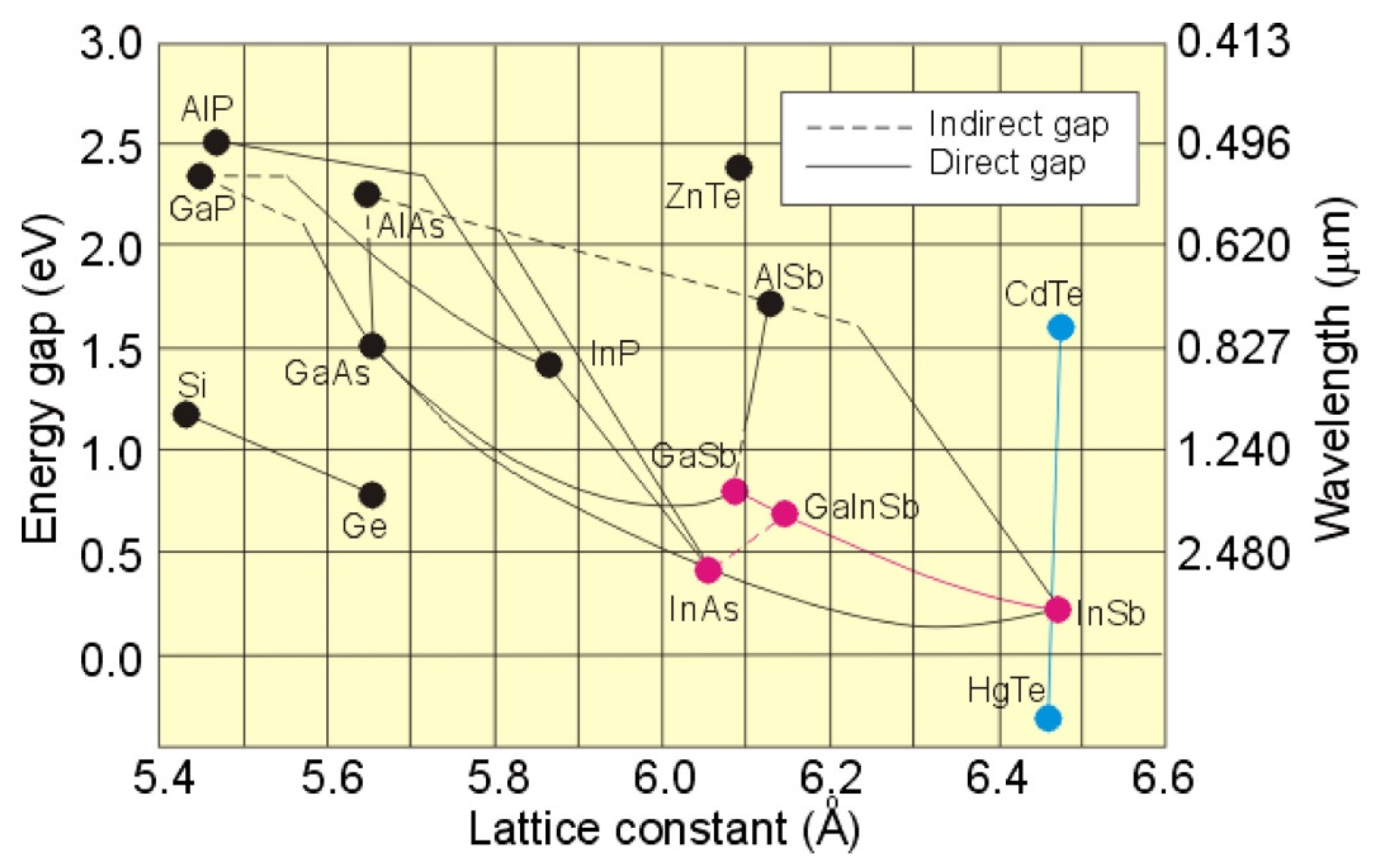
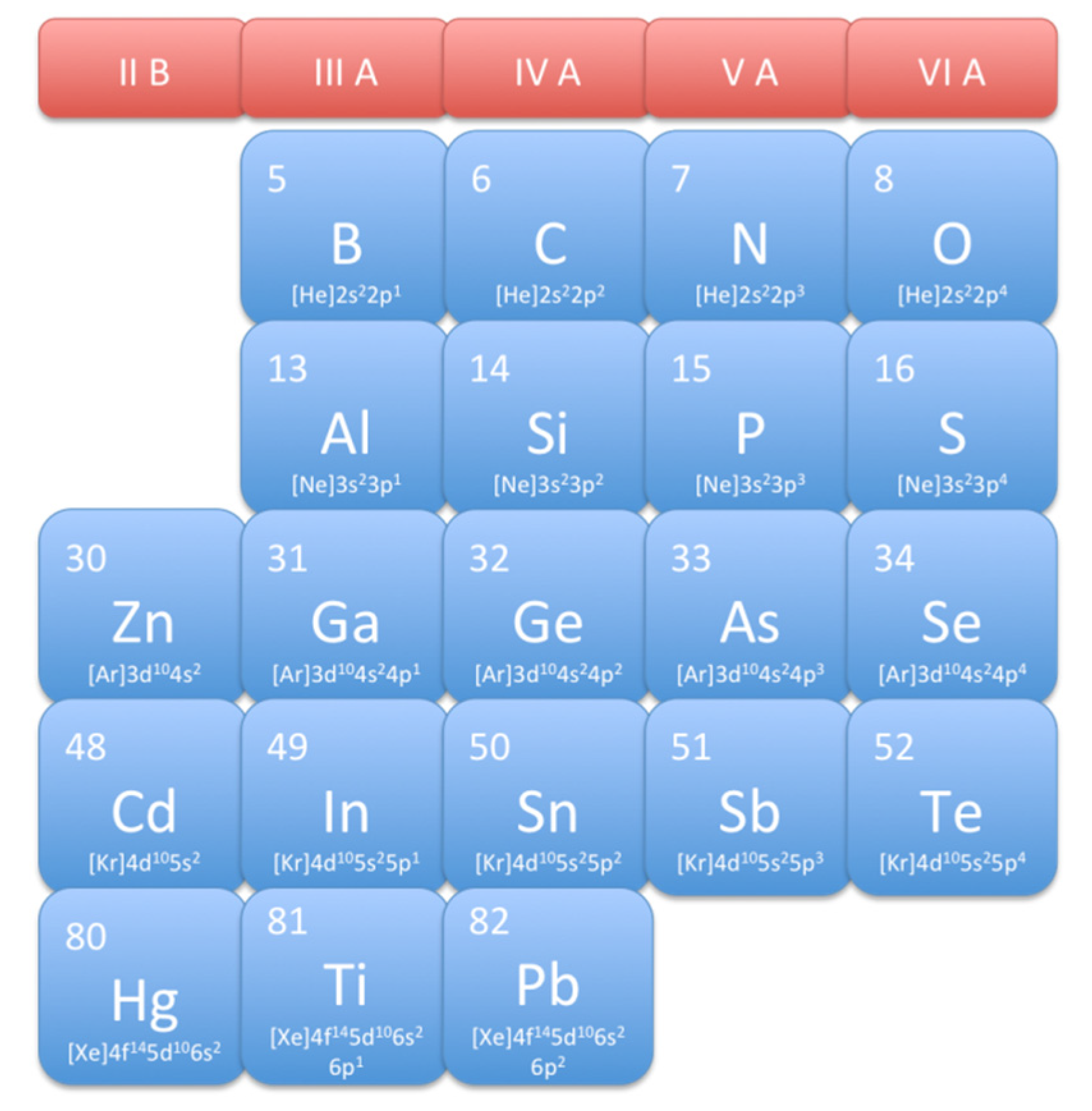

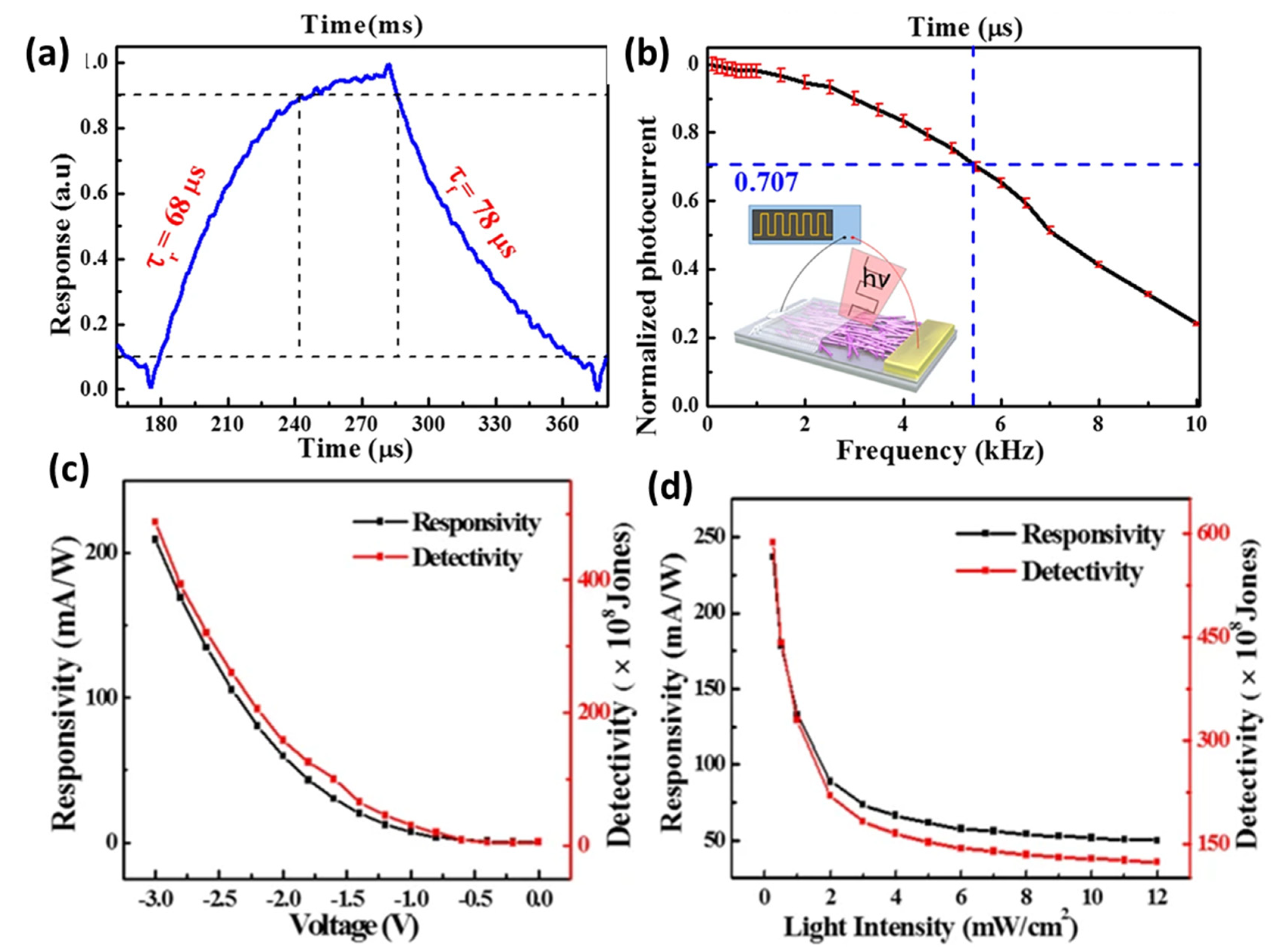
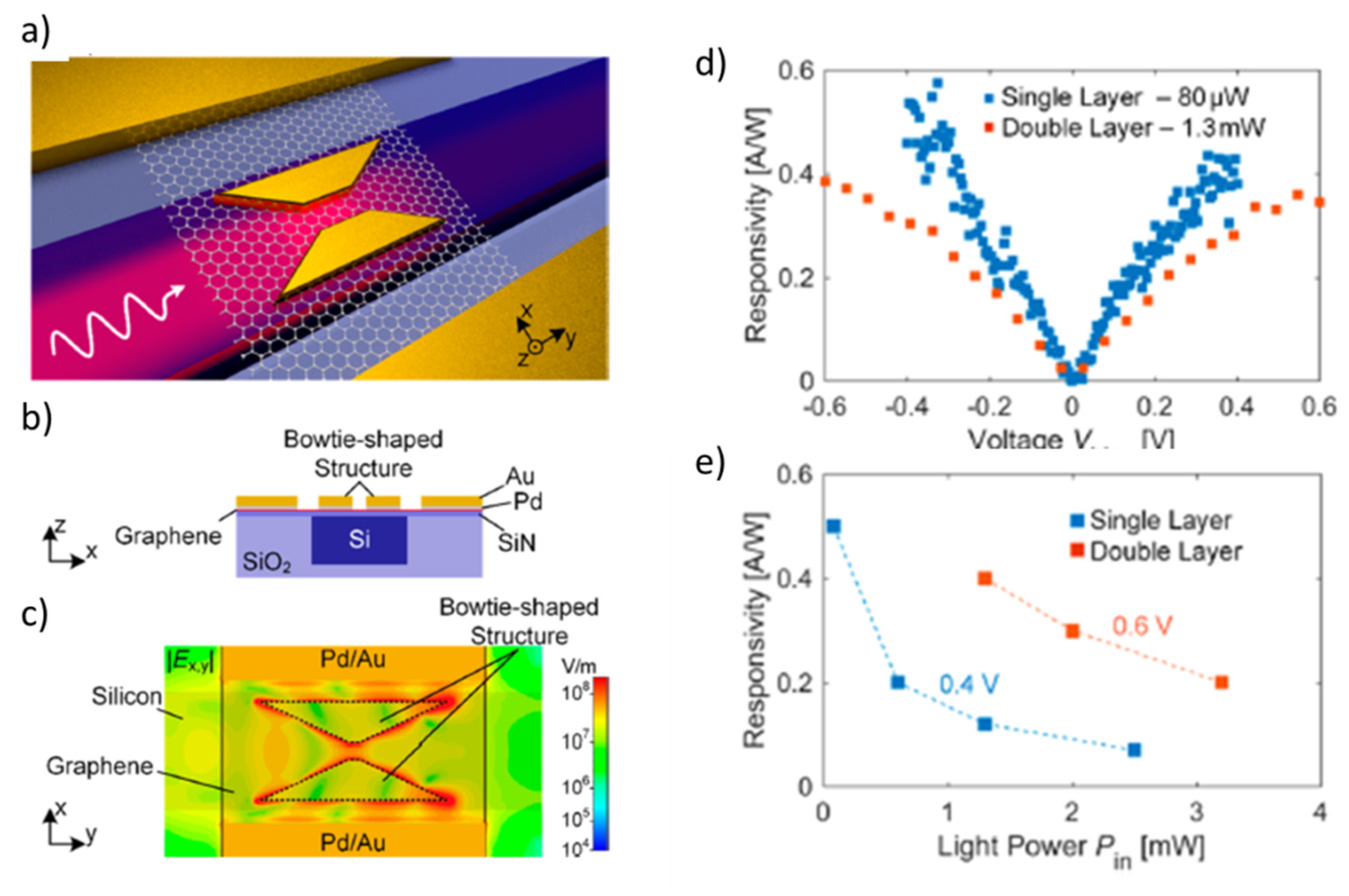
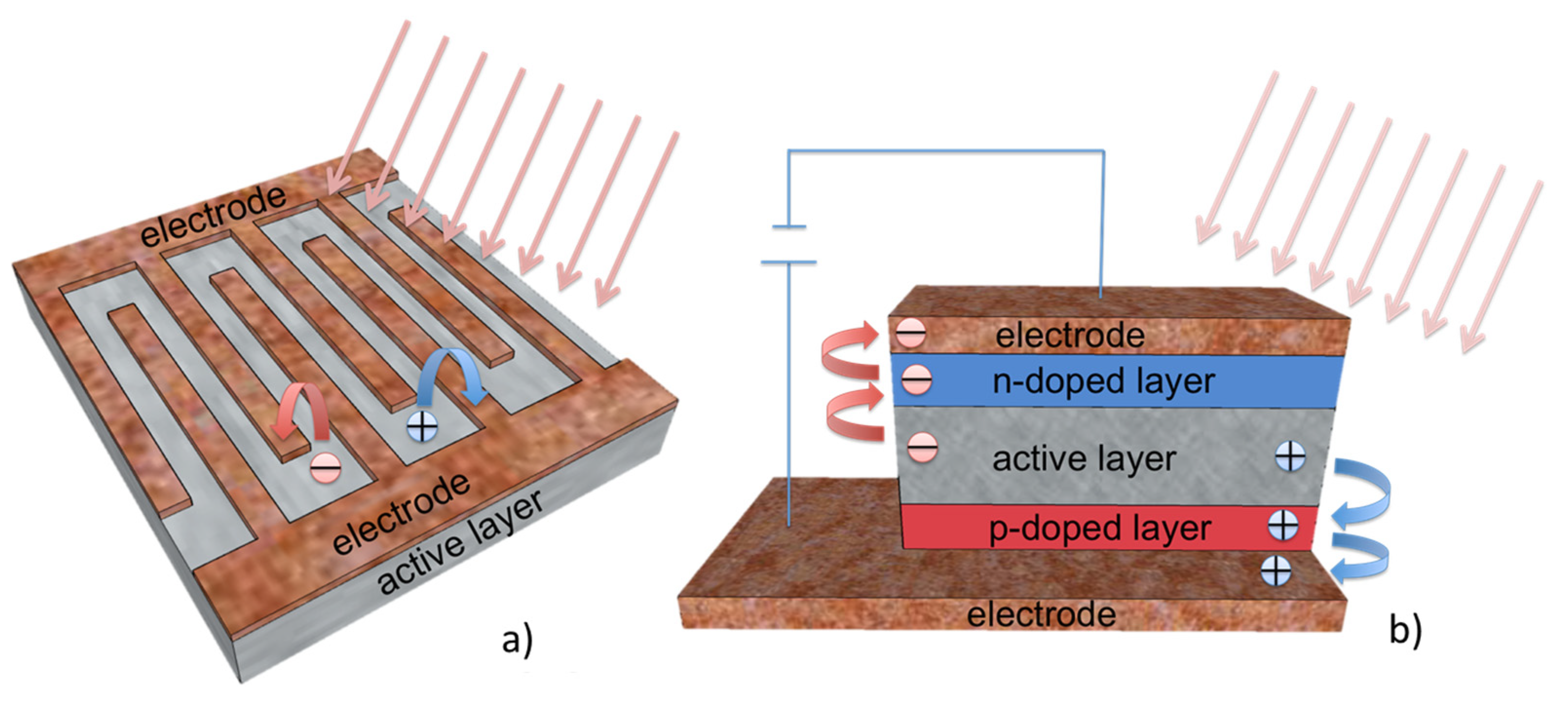
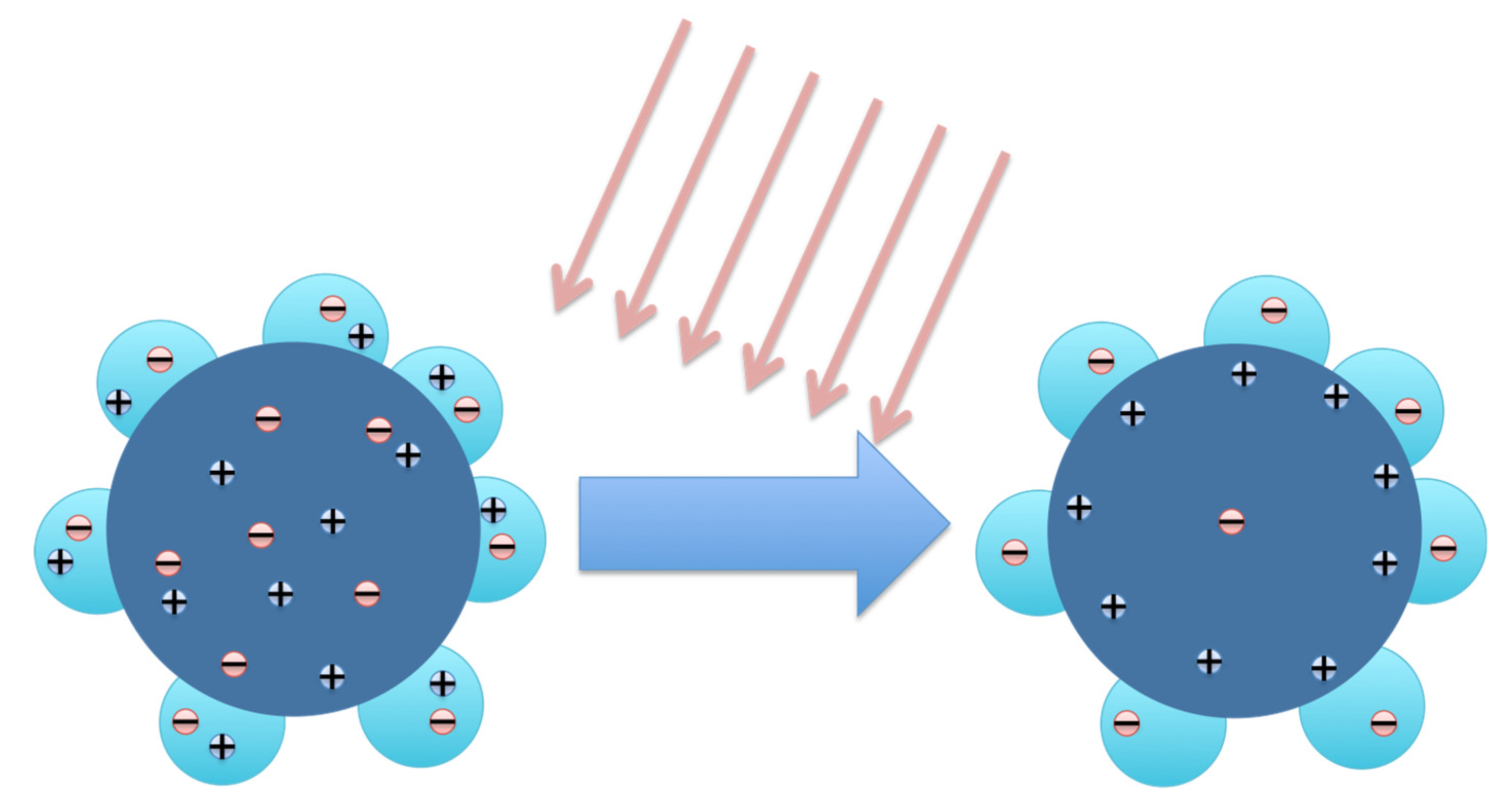
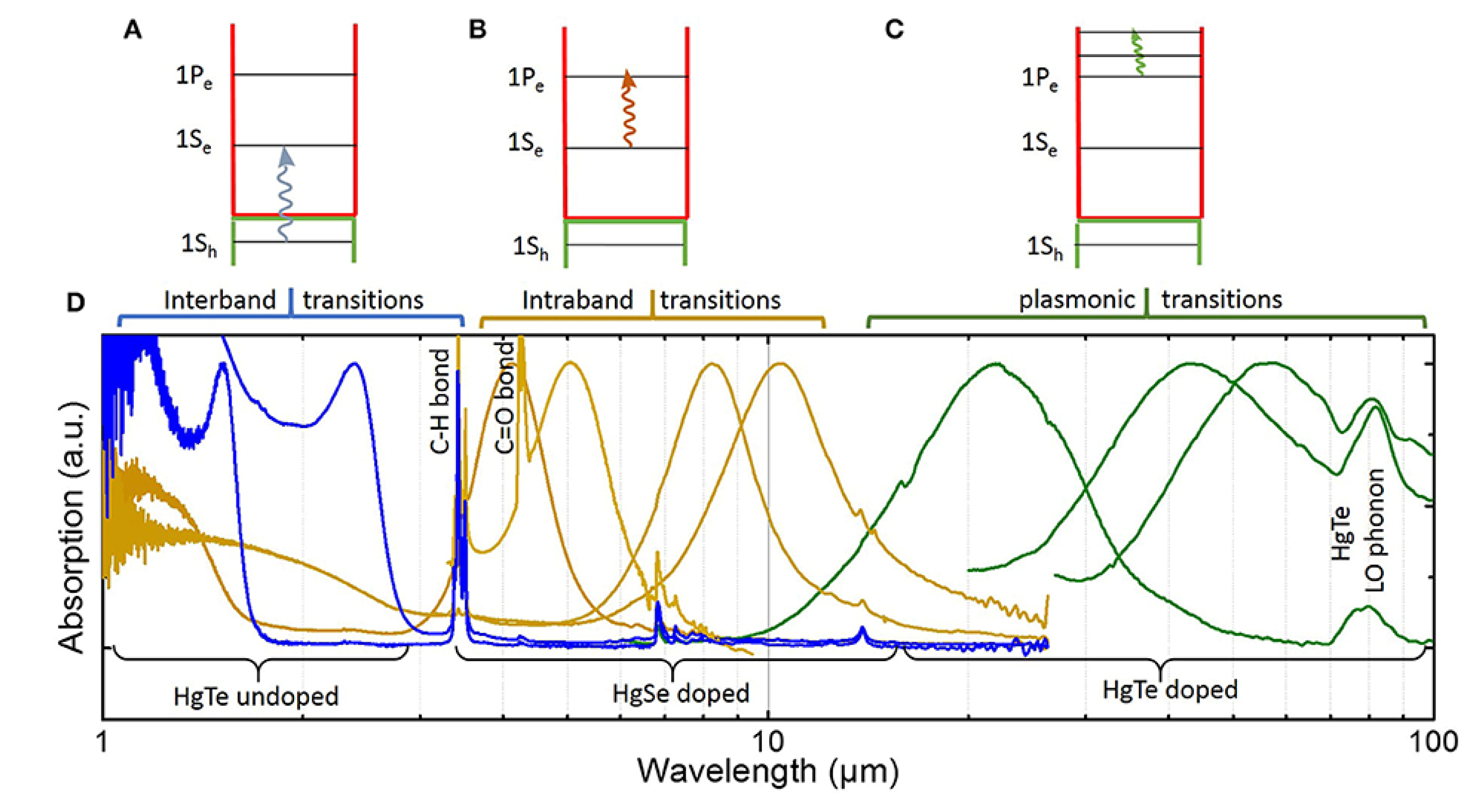
| Material | Eg (eV) | ni (cm−3) | ε | μe (104 cm2/Vs) | μh (104 cm2/Vs) |
|---|---|---|---|---|---|
| InAs | 0.359 | 9.3 × 1014 | 14.5 | 3 | 0.02 |
| InSb | 0.18 | 1.9 × 1016 | 17.9 | 8 | 0.08 |
| PbS | 0.42 | 1.0 × 1015 | 172 | 0.05 | 0.06 |
| PbSe | 0.28 | 2.0 × 1016 | 227 | 0.10 | 0.10 |
| PbTe | 0.31 | 1.5 × 1016 | 428 | 0.17 | 0.08 |
| In0.53Ga0.47As | 0.75 | 5.4 × 1011 | 14.6 | 1.38 | 0.05 |
| Pb0.44Sn0.56Te | 0.1 | 2.0 × 1016 | 400 | 0.12 | 0.08 |
| Hg1−xCdxTe | 0.07–0.25 | (0.23–2.3) × 1016 | 16.7–18.0 | 0.6–1.0 | 0.01 |
| Responsivity (A/W) | Vbias (V) | Operating Wavelength (nm) | Dark Current/Leakage | Effect | Ref. |
|---|---|---|---|---|---|
| 4.6 × 10−3 | −1 | 1550 | 3 nA | IPA NiSi2/p-Si Schottky barrier | [39] |
| 8 × 10−3 | −1 | 1550 | ∼3 nA | MBA Proton implantation | [40] |
| 0.8 × 10−3 | −0.1 | 1550 | 6 μA | IPA Surface plasmon polariton | [41] |
| 64 × 10−3 | −20 | 1440 | 0.1 μA | MBA He2+ implantation | [42] |
| 0.1 | −2 | 1549 | 0.1 nA | MBA Si+ implantation | [43] |
| 8 × 10−6 | −0,1 | 1550 | - | IPA Cu/p-Si Schottky barrier | [44] |
| 0.08 × 10−3 | −1 | 1550 | 10 nA | IPA Cu/p-Si Schottky barrier | [45] |
| 0.5–0.8 | −5 | 1550 | 2.5 nA/mm | MBA Si+ implantation | [46,47] |
| 50 × 10−3 | −0.5 | 1330 | 120 μA/cm2 | MBA Laser irradiation in presence of SF6 | [48] |
| 36 × 10−3 | −11 | 1575 | 0.12 μA | SSA | [49] |
| 0.25 × 10−3 | −15 | 1541.5 | 2.5 nA | SSA-ring resonator | [50] |
| 6 × 10−3 | −3 | 1550 | 15 pA | TPA Photonic crystal resonators | [51] |
| 2 × 10−6 | 1 | 1300 | - | TPA Hemispherical structure | [52] |
| 0.18 | −6 | 1550 | 5 μA | IPA Al-porous Si Schottky barrier | [53] |
| 35 × 10−3 | −0.5 | 1550 | 120 μA/cm2 | MBA in presence of SF6 | [54] |
© 2020 by the authors. Licensee MDPI, Basel, Switzerland. This article is an open access article distributed under the terms and conditions of the Creative Commons Attribution (CC BY) license (http://creativecommons.org/licenses/by/4.0/).
Share and Cite
Dardano, P.; Ferrara, M.A. Integrated Photodetectors Based on Group IV and Colloidal Semiconductors: Current State of Affairs. Micromachines 2020, 11, 842. https://doi.org/10.3390/mi11090842
Dardano P, Ferrara MA. Integrated Photodetectors Based on Group IV and Colloidal Semiconductors: Current State of Affairs. Micromachines. 2020; 11(9):842. https://doi.org/10.3390/mi11090842
Chicago/Turabian StyleDardano, Principia, and Maria Antonietta Ferrara. 2020. "Integrated Photodetectors Based on Group IV and Colloidal Semiconductors: Current State of Affairs" Micromachines 11, no. 9: 842. https://doi.org/10.3390/mi11090842
APA StyleDardano, P., & Ferrara, M. A. (2020). Integrated Photodetectors Based on Group IV and Colloidal Semiconductors: Current State of Affairs. Micromachines, 11(9), 842. https://doi.org/10.3390/mi11090842






